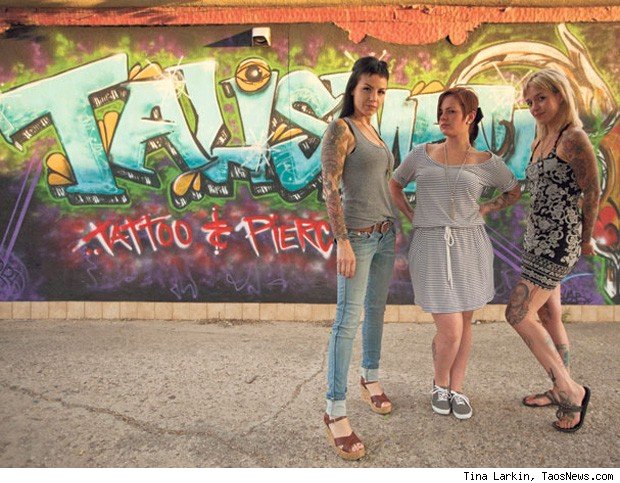 A Day In The Life Of A Tattoo Artist
A Day In The Life Of A Tattoo Artist
Article by: SlingerVille Staff
July 30, 2012
A Day In The Life Of A
Tattoo Artist
Three
women tattoo artists have shared their stories with Jobs.aol.com discussing
what it is really like to be a tattoo artist.
While
it might be unusual to see a tattoo parlor full of women artists, this is the
case for Jess Fitzgerald who owns a tattoo shop in Valdez, N.M. where all the
tattoo artists and piercers are female.
These female artists have shared the inside scoop about their jobs.
Beginning
her career as an apprentice at Harley Davidson eagles at a biker parlor in
Connecticut at 18, Fitzgerald has moved up the ladder in the tattoo world and
just six years later she runs her own shop.
Fitzgerald
discussed working as a woman in profession that is majority male workers, "Being
a girl in a man's world just sort of runs in the family," she says, during
a quiet Wednesday morning at the shop. She points out that her mother has owned
her own electrical contracting firm for 12 years.
Another woman that works for Fitzgerald is 30-year-old Kerry
Burke. Burke had one teacher only keep
her around his shop to scrub toilets and floors because he believed that women
made bad tattoos.
“For both
male and female practitioners, though, tattooing isn't the most stable
profession; the average salary of a body artist in America is $32,000 a year,” according to Simply Hired. But it
varies wildly by geography; a tattoo artist in Boston, for example, makes an
average of $55,000 a year,” according to Indeed.
Burke feels that that kind of money is not usually in the
world of professional art making. She
stated that she lives around galleries full of hundreds of paintings that never
get sold, while she is a commission artists four or five times a day. "I
feel undeserving as an artist," she says, "to be that busy."
Here
is what the girls had to say to Jobs.aol.com about getting their start, the
ethics of tattooing, pain, physical & emotional and their advice for
aspiring tattoo artists:
Getting
Their Start
Apprenticeships have disappeared in most industries
in America, but they remain the only real way to get your start in the world of
tattooing. There aren't many tattooing schools, and you can't practice
permanently dying a person's skin without close supervision.
On Fitzgerald's first day as an apprentice, her
instructor rolled up his pant leg, and had her color in something unfinished.
"You have guinea pigs," Fitzgerald explains. "I've offered
myself as a guinea pig multiple times. It's almost like tattoo karma."
But most apprenticeships aren't so instantly
hands-on. Fitzgerald knows tattoo artists who had to clean the shop for a year
or more before they could touch a needle. Burke gave 100 tattoos for free
during her apprenticeship, in which the customers signed a waiver. "That
was nice," she says, "because when it came out not so awesome, I
didn't want to kill myself."
A good teacher will slowly let you do more
complicated work, Fitzgerald explains. Starting with Chinese characters and
roses and moving on to more elaborately shaded stuff. "There's a lot more
going on than it appears," she says. "You're gauging skin depth.
Compensating for movement, for breathing, for pain."
But even after six years, there are still parts of
the body that Fitzgerald hesitates to tattoo, like the inside of the bicep,
where the skin is "thin, rubbery," and the foot, which is so horribly
painful, they usually only tattoo it in 30-minute chunks. Burke tries her best
to avoid butt cheeks. "They're just really stretchy," she says.
The Ethics
Of Tattooing
When it comes to content, however, Fitzgerald has
few misgivings. She once tattooed a large swastika on a man, who had been
refused at four other places. "Everyone was like, 'Why did you do that?'
" she says. "First of all, it was a huge, so it was very
expensive," she replied. "And I've basically branded this person with
a huge warning to all other humans. That's something I get a kick out of."
Burke feels differently. "The tattoo comes out
of me and goes to this person," she says. "It's sacred and spiritual
in a weird way. I don't want anything like that coming out of me. I don't want
to stencil it. I don't want to color it. I don't want to do it."
But Burke does tattoo some people whom she'd rather
not -- specifically teens. Most states allow minors to get tattooed with the
permission of their parents. "If we turned away minors here, we'd turn
away half our clients," says Burke, who claims that kids as young as 14
will march through the shop's doors, their parents in tow, demanding the same
tattoo as Pauly D from "Jersey Shore."
"Your kid's idol is a club-hopping drunk
person. Sure, I guess I'll do that," says Burke. "I think it's
creepy. And the parents who sign for it are just as creepy."
Pain,
Physical and Emotional
Getting tattooed can be intimate, and sometimes puts
people in an unexpectedly vulnerable place. Tattoo artists often function like
therapists, or at least like bartenders at last call, when the lonely winos
spill their heartbreak. Burke was so embarrassed by her confessions during her
first tattoo session with her teacher that she apologized profusely afterward.
Then when she ended up tattooing her teacher, "suddenly he was crying
about his mom."
But you never know what to expect out of a person.
"Sometimes the 18-year-old girl with the really ambitious thing going up
her side ribs won't make a peep," says Fitzgerald, "while the motorcycle
guy will blubber the whole time."
But in general, when it comes to pain, arms and ankles are
easy, while wrists, lower backs, ribs, armpits, and ribs can be pretty nasty.
"A lot of young women will come in and want something little, like a
little butterfly or a little script, and they pick the worst spots," says
Fitzgerald. Her teacher, who was drenched in ink head-to-toe, said he would do
his Adam's apple again before he did his kneecaps.
Advice For
Aspiring Tattooers
Burke has one piece of advice for tattooing
hopefuls: "Just draw. Draw, draw, draw." Fitzgerald recommends
getting some formal training. "When you draw by yourself, you don't push
yourself, or at least I didn't, to draw things I didn't want to draw." At
art school, she says, you learn perspective and how light works, "things
that almost require instruction."
But you don't necessarily need to get a degree.
"You'll never pay that off in your first few years of tattooing," she
says. But the women at Talisman do have a "break the bank" day once
in a while, especially in the summer, when they walk out with over $1,000.
But there are bad days too. Tattooing isn't the most
consistent way to make a buck. Most tattoo artists are comfortable, however,
with the swings of the seasons. They spend their days permanently marking
bodies with the symbols of love, hope and comfort that their customers hope to
carry with them through their lives. But they've also made mistakes. They know
that "a good artist can cover anything with another tattoo," says Fitzgerald.
And unlike most artists, they know their work will
never hang for generations on museum walls. All of their canvases will one day
decay, just like them. Talisman Tattoo and Body Piercing has just ordered in
new T-Shirts for the shop, with the one slogan that they could all agree on:
"Nothing's Permanent."
Source:
http://jobs.aol.com/articles/2012/07/12/what-its-like-to-be-a-tattoo-artist/
Login to comment
Comments
No comments yet.

